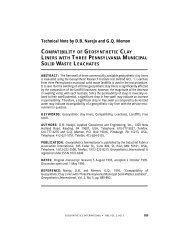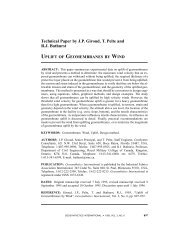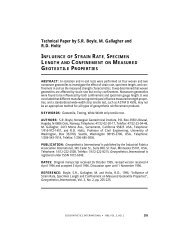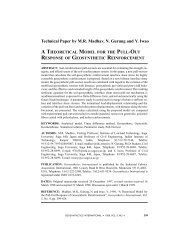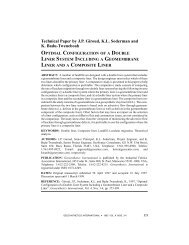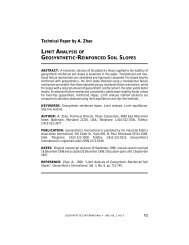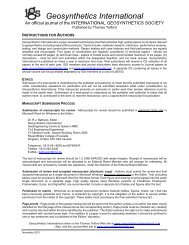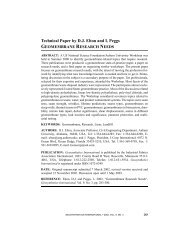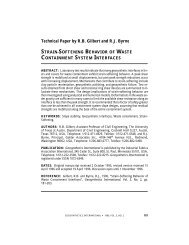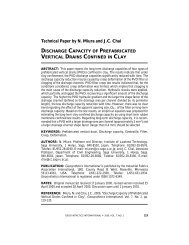Technical Paper by J.H. Greenwood - IGS - International ...
Technical Paper by J.H. Greenwood - IGS - International ...
Technical Paper by J.H. Greenwood - IGS - International ...
Create successful ePaper yourself
Turn your PDF publications into a flip-book with our unique Google optimized e-Paper software.
GREENWOOD D Designing to Residual Strength Instead of Stress-Rupture<br />
Stress-rupture curve<br />
Load or strength<br />
T 3<br />
T 2<br />
T 1<br />
T R3<br />
T R2<br />
T R1<br />
Log t (time)<br />
Figure 3. Residual (available) strength curves, T R1 , T R2 and T R3 , as a function of time for<br />
multiple applied sustained loads T 1 , T 2 and T 3 , respectively.<br />
The residual strength will always be greater than the continuous applied load. Its value<br />
will depend on the mechanism of tensile failure; for example, on the ductile failure<br />
of the remaining cross section of the fibre. It is believed that the residual strength may<br />
remain close to the tensile strength of the geosynthetic for most of the design life, decreasing<br />
only shortly before stress-rupture occurs (Figure 3).<br />
The significance of residual strength was pointed out <strong>by</strong> Schardin-Liedtke (1990),<br />
who also remarked on the lack of available data. The residual strength of geosynthetics<br />
can be measured as described previously in this section. Place the geosynthetic specimens<br />
under continuous load as in stress-rupture tests and interrupt the tests before the<br />
specimen breaks. Then increase the load as in a normal tensile test to determine the residual<br />
strength of the geosynthetic specimen. Plot the curve of residual strength against<br />
the time before interruption. Do the same for each level of continuous load. Considerable<br />
scatter in the values of the data may be expected, particularly close to the stressrupture<br />
limit.<br />
3 UNDERESTIMATION OF THE DESIGN STRENGTH, T D<br />
It is the purpose of this study to reveal that certain aspects of the traditional design<br />
procedure for soil geosynthetic reinforcement, as described in Section 1, can lead to<br />
over-dimensioning due to an underestimation of T D .<br />
It is first necessary to consider the reason for applying a factor of safety. If it is intended<br />
to guard against miscalculation of T CR , or in other words, if there is a possibility<br />
that the actual load applied to the geosynthetic is in fact T CR , then the traditional method<br />
of a design based on stress-rupture is correct. If on the other hand the purpose of the<br />
factor of safety is to keep some strength in reserve to allow for sudden or short-lived<br />
excess loads, then the partial safety factors should reflect the ratio between the applied<br />
4 GEOSYNTHETICS INTERNATIONAL S 1997, VOL. 4, NO. 1



